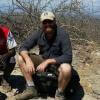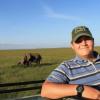Human-wildlife conflict and coexistence is a shockingly common problem, often with enormous consequences for both individual animals and entire populations.
When human-wildlife conflict comes to mind, you may immediately think of wildlife crime instead - which isn't wrong, since many regions with wildlife crime problems like poaching are also areas where people may frequently deal with human-wildlife conflict, causing the two issues to go hand-in-hand. But human-wildlife conflict is a much broader issue encompassing many ways that human presence and interference can cause problems for us and animals alike. Human-wildlife conflict includes:
- Elephants trampling a farmer's crops, resulting in retaliation
- New real estate developments infringing on ecosystems where predator species live, leading to predators having less territory and less food, which in turn leads to predators attacking domestic animals and livestock
- Freeways dividing the territory of animals like mountain lions, leading to wildlife venturing into neighborhoods or being killed by cars
- Lead bullets used in hunting causing scavengers like condors to die of lead poisoning
These are just a few examples of how humans can negatively impact wildlife, and it's clear to see how many of these scenarios could escalate. Human-wildlife conflict solutions don't just include ways in which we can prevent these issues (for example, through tracking predators, monitoring populations' territories, or building barriers and wildlife crossings monitored by sensors), but also the ways in which we can help people connect with wildlife and care about learning to live alongside them.
If you're interested in solutions that can prevent human-wildlife conflict, join this group and get to know the people who are working to protect and save species around the world!
Header image: Casey Allen on Unsplash
No showcases have been added to this group yet.
- 1 Resources
- 0 Discussions
- 12 Groups
- @samarmstrong
- | She/her
International Union for the Conservation of Nature (IUCN)
Invasive species/law enforcement/project management/Asia/Australia

- 0 Resources
- 0 Discussions
- 4 Groups
- @brittanypalmer
- | she/her
Entrepreneur and environmental attorney with a passion for wildlife conservation.
- 0 Resources
- 0 Discussions
- 4 Groups
- @Charlotte_Christensen
- | She/her
University of Zurich
Behavioural ecologist working on integrating animal behaviour into conservation solutions


- 0 Resources
- 0 Discussions
- 3 Groups
- @magali
- | she/her
Swedish University of Agricultural Sciences
Postdoctoral researcher at Swedish University of Agricultural Sciences
- 0 Resources
- 0 Discussions
- 16 Groups
- @Doniham
- | She/her
Machine Learning Developer willing to contribute to AI for the planet projects
- 0 Resources
- 2 Discussions
- 3 Groups
- @cjturner
- | he/him
Computational Ecologist working on camera traps, audio, tracking and remote sensing.
- 0 Resources
- 0 Discussions
- 4 Groups
- @Aoife_Göppert
- | She/ Her
PhD research student at Queen's University Belfast, a QUADRAT DTP funded project.
- 0 Resources
- 0 Discussions
- 10 Groups
Entrepreneur building AI-driven acoustic monitoring technology for comprehensive wildlife conservation, protection and ecosystem health monitoring.

- 0 Resources
- 0 Discussions
- 4 Groups
- @ChrisThouless
- | Dr
Director of Elephant Crisis Fund, Research Director of Save the Elephants
- 0 Resources
- 0 Discussions
- 2 Groups
- @Aurora
- | she/her
I'm a PhD student and the main topic of my research project is large carnivores' activity rhythms. I am passionate about statistical modeling, specifically through a Bayesian approach.
- 0 Resources
- 1 Discussions
- 6 Groups
Forgotten Parks Foundation
- 0 Resources
- 3 Discussions
- 5 Groups
A recent online video of a baby bear's efforts to scale a steep cliff took what seemed like an inspirational moment viral. But after the initial enthusiasm for the video came some controversy when scientists pointed out...
22 November 2018
In this case study, Katarzyna Nowak writes about her work with the Southern Tanzania Elephant Project (STEP) trialing beehive fences as human-elephant conflict mitigation tools. Earlier this year the research team...
27 August 2018
The understanding of the interplay of movement, behaviour and physiology that biologging offers has applied relevance for a range of fields, including evolutionary ecology, wildlife conservation and behavioural ecology...
30 July 2018
The winners of our Human Wildlife Conflict Tech Challenge are offering regular updates throughout the year to chronicle their failures, successes and what they learn along the way as they develop their solutions. In...
27 July 2018
As people continue to move into natural habitats, conflicts between human beings and wildlife continue to rise. Although there are a number of early-detection systems and tools in place to prevent human-wildlife...
5 June 2018
Conflict between humans and wildlife is increasing as human communities expand and wild habitats are destroyed, prompting need for new mitigation techniques. As a winner of the Human Wildlife Conflict Tech Challenge,...
19 April 2018
‘The Field’… Say the words ‘The Field’ to a group of conservationists and it will immediately conjure up vivid memories of everything from sticky wet rainforests to burning dusty deserts. What’s more, it’s almost...
17 January 2018
Article
A new research project is looking to investigate whether technology combined with the ancient skills and knowledge of Namibian trackers can help save cheetahs from extinction. Called FIT Cheetahs, the research project...
4 December 2017
We are delighted to announce that British conservation technologist Alasdair Davies and the Dutch team of Laurens de Groot and Tim van Dam from the ShadowView Foundation are the winners of the first international Human...
1 November 2017
Our panel of international experts has been hard at work reviewing the 47 proposals we recieved for innovative technological tools to address human wildlife conflict. The panelists have systematically been assessing the...
20 October 2017
The inherent complexity of not only deploying technologies in the field but also doing so in a scientifically rigorous manner can prove a substantial barrier for the effective use of conservation technologies, and clear...
11 October 2017
The Domain Awareness System (DAS) is a revolution in monitoring technology, creating real-time awareness of protected areas assets. This technology has the potential to completely change standard monitoring procedures...
26 September 2017
October 2025
event
July 2023
event
June 2023
event
32 Products
3 R&D Projects
42 Organisations
Recently updated products
Recently updated R&D Projects
Recently updated organisations
| Description | Activity | Replies | Groups | Updated |
|---|---|---|---|---|
| HWC Tech Challenge Update WInners to be announced on the 1st November, 2017 First of all, we’d like to thank you all again for your interest and participation in the... |
|
Human-Wildlife Coexistence | 7 years 9 months ago | |
| Hello, this device looks really interesting...has anyone tryed? what brand is it? how much does it cost? what's the range of the speakers? what kind of sound does it makes? I... |
|
Human-Wildlife Coexistence | 7 years 10 months ago | |
| Hi Mark and Teun, we have been investigating this technology also. It is already being used, but has two problems. First, their reach is often very limited (around 50m) and the... |
+13
|
Human-Wildlife Coexistence | 7 years 11 months ago | |
| Dear Somak, Thank you very much for writing and we are sorry information on the challenge did not reach you in time. We are certainly interested in furthering discussions... |
+14
|
Human-Wildlife Coexistence | 7 years 11 months ago | |
| Hi Gwen, That's a tough question Gwen! And for any destination in the Arctic counts: it is horribly expensive! I suggest you count on Iqaluit in Nunavut-Canada. Access is... |
+12
|
Human-Wildlife Coexistence | 7 years 11 months ago | |
| Thank you, Gert. My proposed solution takes security into account heavily. Excited to share it with you and the panel as well. Claire |
+7
|
Human-Wildlife Coexistence | 7 years 11 months ago | |
| Additional information on human-polar bear conflicts can be found in this article |
|
Human-Wildlife Coexistence | 8 years ago | |
| Friends and fellow researchers in the WILDLABS community I would like to hear your valuable opinions on the doctoral research project I am... |
|
Human-Wildlife Coexistence, Funding and Finance | 8 years ago | |
| For those interested: in the acoustics channel I have posted news on our sound event recognition sensor, using conv-net: https://... |
|
Human-Wildlife Coexistence | 8 years 3 months ago | |
| Hello all! There's going to be a workshop led by Human Wildlife Conflict Collaboration on the fundamentals of HWC. It will... |
|
Human-Wildlife Coexistence | 8 years 3 months ago | |
| Peter, thanks for your reply and sorry for the dealyed repsonse, I have been ahving some issues getting alerts in my email. I would like to talk to you more about your... |
|
Human-Wildlife Coexistence | 8 years 4 months ago | |
| Hi Udayan, Many thanks for following up and it's great to hear that it's an area of interest for you as well. I'm certainly interested to hear more about the work... |
|
Human-Wildlife Coexistence | 8 years 7 months ago |


































